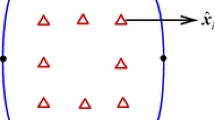Abstract
A new method of direct numerical evaluation of hypersingular boundary integrals has been applied to the differentiated form of the Somigliana-identity (hypersingular identity) in 3D-elastostatics. Through this method it is possible to evaluate the stress tensor on the boundary of a complex 3D structure in a very accurate manner by employing the direct boundary element method (BEM). The geometry of the elements and their arrangements over the boundary of the structure are not subjected to any restrictions. Numerical examples illustrate the accuracy of the proposed method.
Similar content being viewed by others
References
Bialecki, R.; Dallner, R.; Kuhn, G. (1992 to appear): New application of hypersingular equation in the boundary element method. Comp. Meth. Appl. Mech. Eng.
Chien, C. C.; Rajiyah, H.; Atluri, S. N. (1990): An effective method for solving the hypersingular integral equation in 3D acoustics. J. Acoustical Soc. of America 88, 918–937
Chien, C. C.; Rajiyah, H.; Atluri, S. N. (1991): On the evaluation of hypersingular integrals in the boundary element method for linear elasticity. Comput. Mech. 8, 57–70
Dallner, R.; Kuhn, G. (1992 to appear): Efficient evaluation of volume integrals in the boundary element method. Comp. Meth. Appl. Mech. Eng.
Guiggiani, M.; Krishnasamy, G.; Rudolphi, T. J.; Rizzo, F. J. (1991): Hypersingular boundary integral equations: A new approach to their numerical treatment. In: Morino, L.; Piva, R. (eds.). Boundary Integral Methods. Proc. IABEM-Symposium, October 15–18, 1990, Rome, Italy, pp. 211–220, Berlin: Springer
Guiggiani, M.; Krishnasamy, G.; Rudolphi, T. J.; Rizzo, F. J. (1992): A general algorithm for the numerical solution of hypersingular boundary integral equations. ASME J. Appl. Mech. 59(3), 604–614
Hildenbrand, J.; Kuhn, G. (1992a). Numerical computation of hypersingular integrals and application to the boundary integral equation for stress tensor. Eng. Anal. Boundary Elements 10, 209–217
Hildenbrand, J.; Kuhn, G. (1992b to appear): Finite part integrals under nonlinear coordinate transformation in two-dimensional boundary element analysis. Int. J. Numer. Engng.
Howland, R. C. J. (1930): On the stresses in the neighbourhood of a circular hole in a strip under tension. Phil. Trans. Roy. Soc., Lon. A 229, 49–86
Huber, O.; Kuhn, G. (1992): Evaluation of the J-integral for 3D crack problems using the hypersingular identity. In: Brebbia, C. A.; Dominguez, J.; Paris, F. (eds.). Proceedings of the 14th Boundary Element International Conference, November 3–6, 1992, Seville, Spain, Vol. 2, 367–381. Southampton: Computational Mechanics Publications
Jaeger, J. C.; Cook, N. G. (1979): Fundamentals of Rock Mechanics. London: Chapman and Hall
Krishnasamy, G.; Rizzo, F. J.; Rudolphi, T. J. (1992): Continuity requirements for density functions in the integral equation method. Comput. Mech. 9, 267–284
Kuhn, G.; Huber, O. (1991): Arbeitsbericht zum DFG-Schwerpunktprojekt: Behandlung dreidimensionaler elastoplasticher Kerb-und Rißprobleme mittels Randelementmethode. Erlangen 1991
Okada, H.; Rajiyah, H.; Atluri, S. N. (1988a). Non-hypersingular integral equation representation for elocity (displacement) gradients in elastic/plastic solids (small or finite deformations). Comput. Mech. 4, 165–175
Okada, H.; Rajiyah, H.; Atluri, S. N. (1988b): A novel displacement gradient boundary element method for elastic analysis with high accuracy. ASME J. Appl. Mech. 55, 786–794
Schwab, C.; Wendland, W. L. (1992a): Kernel properties and representations of boundary integral operators. Math. Nachr. 156: 187–218
Schwab, C.; Wendland, W. L. (1992b): On numerical cubatures of singular surface integrals in boundary element methods. Numer. Math. 62, 343–369
Zhang, Ch.; Achenbach, J. D. (1989): A new boundary integral equation formulation for elastodynamic and elastostatic crack analysis. ASME J. Appl. Mech. 56, 284–290
Author information
Authors and Affiliations
Additional information
Communicated by S. N. Atluri, December 9, 1992
Rights and permissions
About this article
Cite this article
Huber, O., Lang, A. & Kuhn, G. Evaluation of the stress tensor in 3D elastostatics by direct solving of hypersingular integrals. Computational Mechanics 12, 39–50 (1993). https://doi.org/10.1007/BF00370484
Issue Date:
DOI: https://doi.org/10.1007/BF00370484




